Viva Cuba!/OCZ RevoDrive PCI-Express SSD Review

|

Quick Click Links
Feature Photograph
Viva Cuba!I OCZ RevoDrive PCI-Express SSD, A Review
Photography News of Interest
Readers Submissions
Readers Questions A Snapshot of Bangkok Images Week in Review
Infocus Blog, Cycling ThailandT
Feature Photograph *menu

Panasonic G1 @f6.3 1/320th 45mm ISO 100 (photo credit to Akulka)
Just as the holidays started, regular contributor Akulka sent me a series of images from Cuba. As soon as I saw them I knew I wanted him to turn them into a feature (which you can read below, Viva Cuba!) and that several of the images were worthy of being Feature Photographs and further discussion. This image is my favorite.
I asked Akulka to send me the RAW image so I could process the image for effect and discuss it here in the Feature Photograph section. Soon I had the raw image and I spent some time looking at it and trying different methods of processing. There are a zillion ways to process an image, but I wanted this one to keep with the colorful and flamboyant theme of Havana Cuba.
Why do I like this image? The elements of the composition and the perspective. These older cars are a regular fixture in Cuba and everyone expects to see them so the car was a given. The couple on the bike next to the car was a bonus. They might be native Cubans, or curious tourists. It doesn’t really matter, the juxtaposition of couple on the bike, side by side with the car, was brilliant and I’m sure not that easy to capture.
The perspective is topping on the cake. Notice how you can see under the car as it looms towards you in the frame, while the couple on the bike look very natural. The cloud cover and background building were the perfect backdrop. The wet concrete, shadows, and shiny reflections all compliment the scene while providing an interesting foreground. The license plate clearly showing “Cuba” is another bonus. This is a textbook image. In my opinion, timeless.

Let’s look at the original image. The camera’s meter exposed for the bright sky behind, underexposing the main subjects (couple on bike and car). Akulka could have dialed in some positive exposure compensation to correctly expose the main subjects, but this would have resulted in a blow sky. I think he balanced it nicely, such balancing is a fact of life with digital cameras. Yet, it leaves you with an unremarkable flat image.
My goal in the processing was to bring out the natural colors of the couple on the bike and the car, while further reducing the exposure of the background sky. I wanted the main subjects to stand out in the frame and fit the theme of flamboyant Havana. What do you think, did I succeed?
Viva Cuba! *menu
 Allow me to introduce Akulka. Akulka is well known in the Readers Submissions' area of Stick’s site and has penned three other features for this column in the past. All exotic, all enjoyable. He is well travelled and always has an interesting perspective. You can contact Akulka at: argonaut942@gmail.com
Allow me to introduce Akulka. Akulka is well known in the Readers Submissions' area of Stick’s site and has penned three other features for this column in the past. All exotic, all enjoyable. He is well travelled and always has an interesting perspective. You can contact Akulka at: argonaut942@gmail.com
For several years I’d been thinking about visiting Cuba until I finally turned this idea into reality in November 2010. I traversed almost the entire length of the island from East to West over the course of three weeks, mostly travelling by bus or other forms of public transport. Despite having been somewhat skeptical if Cuba would meet my travel needs and interests before going, I gladly found it exceeded my expectations in many ways. In fact I consider it one of the most fascinating countries of all the places I’ve ever travelled.
When I’m taking pictures I’m usually not just looking for interesting or simply beautiful motives. As much as possible I try to find meaning in details, or look for subjects rich in incongruity, in the sense of finding elements that seem to be at odds with their context, which is easier said than done. The same goes for taking pictures which express basic human values, emotions, or beliefs. What follows is a selection of some of my photos from all around Cuba. Some of the pictures more or less meet the criteria, while others don’t.
All photos were taken with my well tested Panasonic G1 Micro 4/3 camera which I have generally been very happy with. One of the features of the camera I have come to appreciate most is its swivel LCD screen, allowing for interesting and unusual perspectives. All images underwent some more or less basic post-processing using Adobe’s Lightroom 3.

Panasonic G1 Micro, @F5.6 1/125th 46mm ISO 100
In Cuba one can opt to stay in regular hotels, or in private guesthouses. To me and many others the private guesthouses (Casas Particulares) are the far more interesting option, as they allow for interaction with Cubans from all walks of life who rent out spare rooms to foreigners all around the country. This is the view from the balcony of my “Casa” in central Havana. In the distance looms the Capitolio, the most famous landmark of the city. Taking this picture was a bit tricky because of the backlight from the rising sun.

Panasonic G1 Micro, @F6.3 1/125th 24mm ISO 200 HDR Processed
What looks like a train cemetery is actually a restoration yard for decommissioned steam engines. Out of necessity nothing gets wasted in Cuba, so some of these decrepit old-timers will eventually find their way back onto tracks and into service. The yard is located in the very center of Havana, just a few minutes’ walk from the Capitolio. A worker noticed me taking an interest and was kind enough to walk me through the compound. This photo is an HDR, composed of three pictures, taken handheld, at -2/0/+2 exposures.

Panasonic G1 Micro, @F7.1 1/250th 58mm ISO 100
A spruced up old-timer taxi in Havana Vieja. There are lots of old-timers on the roads all over the country, adding to that special ambience of long past times Cuba is well known for. While most old-timers look their age and are often only able to be kept on the roads due to the mechanical ingenuity of their owners, this one has obviously been looked after very well. Photo taken from the ground level up, taking advantage of my camera’s useful swivel screen, to provide a different and more interesting perspective.

Panasonic G1 Micro, @F6.3 1/1000th 194mm ISO 200
Baseball for the revolution. “Pelota”, as baseball is commonly referred to, is Cuba’s national sport, draws crowds, and stirs up passions. Wandering through the streets of Havana one can see people playing everywhere, often using iron rods and stones in lieu of real bats and balls. The kids in this picture were lucky to have proper equipment, playing on Havana’s “Revolutionary Square” where often political events get staged. Photo taken sitting on the ground.

Panasonic G1 Micro, @F5.6 1/40th 90mm ISO 100
While most Cubans are simply trying to get on with their daily lives and cope with the bad cards they have been dealt with, the revolutionary propaganda is well and alive all over the country. “Revolutionary committees” organize rallies on a local level, and posters, billboards, and graffiti praising the revolution and its leaders can be seen everywhere.

Panasonic G1 Micro, @F7.1 1/320th 34mm ISO 100
The port of Baracoa, Cuba’s easternmost city. Baracoa’s landmark flat-top mountain, El Yunque, is in the background. Because of the US enforced trade embargo against Cuba, few ships call to port here, and most supplies arrive via the famously steep mountain roads that traverse the “Cuban Himalaya”, connecting the otherwise isolated city with the rest of the country.

Panasonic G1 Micro, @F6.3 1/400th 56mm ISO 100
Maguana, 20 miles east of Baracoa, is a beautiful “wild” beach. Very few foreign travelers make it here, in stark contrast to the resort areas with their high-end hotels and package tourism along the beaches of Varadero etc.

Panasonic G1 Micro, @F10 6secs 74mm ISO 100
Baracoa’s seafront at low tide at dusk. Photo taken using a tripod.

Panasonic G1 Micro, @F7.1 1/250th 42mm ISO 100
Playa Duaba, another scenic wild beach near Baracoa. Other than at Maguana, swimming is not advisable here because of strong undercurrents. Photo taken an hour before sunset.

Panasonic G1 Micro, @F8 1/320th 40mm ISO 100
Out of necessity cycling is for most the only viable mode of transport other than walking. I took this picture from ground level.

Panasonic G1 Micro, @F7.1 1/1250th 400mm ISO 200
Honor guard at the tomb of Josef Marti at Santiago de Cuba’s famous Santa Ifigenio cemetery.

Panasonic G1 Micro, @F9 1/6405th 90mm ISO 100
“Big Boy” parked in front of Los Angeles hospital in Santiago de Cuba. Again, I took this picture from ground level.

Panasonic G1 Micro, @F5 1/250th 28mm ISO 320
Surprisingly Cubans know a thing or two about ice-cream. While it’s not comparable in quality or taste to real Italian gelato, it’s a ready available treat in Cuba’s tropical climate, and very cheap to boot. One cone of coconut flavored ice-cream goes for 0,01US$.

Panasonic G1 Micro, @F3.5 1sec 28mm ISO 100
A piglet is slowly bleeding to death on the streets of Santiago de Cuba. Meat is a rare treat for most Cubans. I came upon this scene by chance and had to react quickly if I wanted to get an interesting shot. I chose “Auto Mode” on my camera and took a few pictures. This one turned out best.

Panasonic G1 Micro, @F5.4 1/15th 56mm ISO 100
A Cuban shop, like many others, with mostly empty shelves. At the few supermarkets that can only be found in larger towns and cities, security measures are stringent to prevent theft.

Panasonic G1 Micro, @F7.1 1/125th 28mm ISO 100
“Valle de los Ingenios” is a beautiful tropical valley near the colonial town of Trinidad in central Cuba. HDR composed of 5 exposures ranging from -2 to +2. A tripod was used.
Akulka –
WOW! I truly enjoyed this. Great pictures and a captive narrative. Very enjoyable.
Thank you
Steve
OCZ RevoDrive PCI-Express SSD Review *menu

Introduction
2010 was the year of the Solid State Drive (SSD). In just one year SSD’s went from being ultra-expensive rather specialized pieces of equipment for the most dedicated enthusiasts, to almost mainstream affordable devices for anyone looking to improve on the snail slow mechanical hard drive. Price drops have been huge as the market saturates with products from many manufacturers. Windows 7 directly supports SSD’s TRIM function which helps maintain performance levels in the long run.
So it’s no surprise we’re on to the next level for 2011. Traditional (if you can call them that after only a year) SSD’s come in a standard 2.5” laptop size format which ends up working well in any computer through a standard SATA II port, and there’s even been a single entry in the market taking advantage of the SATA III interface we reviewed here last year. But already the newest chips and controllers can even saturate (exceed) the capabilities of the mighty SATA III port and the logical new interface is a direct connection to the main bus via the PCI Express port commonly used for video cards.

Enter OCZ’s RevoDrive PCI Express SSD available in sizes from 50-480gb’s with read and write speeds approaching 540mbps read and 450mbps write, and there are even newer RevoDrive 2 PCI Express SSD in sizes of 100-960gb’s with 740mbps reads and 690mbps writes! To put that in perspective my Crucial C300 SATA III SSD can barely achieve 50,000 IOPS. The RevoDrive achieves 75,000 IOPS and the RevoDrive 2 100,000 IOPS. Now that’s screaming fast! All you need is a free 4x PCIe slot on a fairly modern motherboard.
The OCZ RevoDrive
As much as I enjoy the newest fastest toys I didn’t see spending the nearly $800 US for a 240gb RevoDrive 2 SSD. I tried hard to justify it, but even my current Crucial C300 is blindly fast for my uses. You can only be so wet right? When making my SSD selection for a new student workshop PC I looked closely for value vs. speed vs. capacity. I considered another Crucial C300 or OCZ’s excellent Vertex II, but both were more expensive than the RevoDrive’s $459 US price tag for a like capacity. Yet, the Revodrive was a good 33.3% faster than my Crucial C300!

I’d read a lot of posts on forums from unhappy RevoDrive customers so let’s address this first. I’d even had people warn me not to buy one because they couldn’t get it to work. So I decided to investigate myself by speaking with an OCZ representative and those on forums who were happy. Why such a huge chasm of customer satisfaction? Really, it boils down to early adopters, old motherboards, slow BIOS updates from motherboard manufacturers, unrealistic expectations, and inexperience. I still think the Revodrive is an “intermediate” skill level device best left up to your PC builder or skilled enthusiasts. We’ll get more into that later.
Early adopters wanting their RevoDrive to serve as a boot device quickly found their motherboards didn’t yet support PCIe boot devices. This wasn’t something OCZ could fix other than to work closely with the manufacturers to ensure rapid BIOS updates were forthcoming and this they did. Within months most every current motherboard on the market now supports the RevoDrives after installing the most current BIOS updates. Here is a list of compatible motherboards and any issues there might be with them. I would advise you pay rapt attention to this list before ordering your Revodrive.
When I said “unrealistic expectations” I was referring to those who purchased a leading edge device expecting foolproof plug n’ play compatibility and operation the same as a SATA II device. RevoDrive’s as you’ll soon read below aren’t that difficult to install, but they do require steps not required with SATA II devices and compatible motherboards. I tested the RevoDrive with a Gigabyte X58-UD7 Rev 1 with the F7 BIOS, and a brand new Asus Rampage Gene III with their latest 704 BIOS. Both worked flawlessly.
With that out of the way let’s talk about the RevoDrive. It’s a PCI Express x4 half height card available in capacities from 50-480gb’s. It can be used as a standalone storage device, or a boot drive with operating temperatures of up to 70c. It uses 3 watts at idle, 8 watts under load, is compatible with all versions of Windows since XP, comes with a 3 year warranty, and has a MTBF (mean time between failures) of 2,000,000 hours.. That’s 2 million hours, or 228 years! It’s a reliable device.

The RevoDrive is an internal RAID 0 device which spans two drives into one with an onboard RAID controller. In the case of the 240gb drive it spans (2) 120gb drives in a RAID 0 configuration for a total of 240gb capacity using 2 SandForce controllers. The onboard RAID controller is much better than RAIDing two regular SSD’s using the motherboard’s RAID controller which draws resources from the CPU.

It comes in a box with the RevoDrive PCIe card, and a small instruction booklet. That’s it. Nothing more is needed.

Installation
This is the part you’ll want to pay attention to. It’s not that difficult if you follow these steps exactly. I’ve taken the liberty of including extra steps you might not need on ‘your’ motherboard for the sake of making one set of instructions which will work on all compatible motherboards. Don’t install the RevoDrive until step F.
- Ensure you have a compatible motherboard and flash the very latest non-beta BIOS available. Go to your motherboard manufacturers website, go to support, download drivers, and look for the instructions and files for the BIOS update. Get this done BEFORE installing the RevoDrive in your system.
- Enter your BIOS and disable all boot drives other than your CD/DVD drive. Disable any SATA III controllers until after installation is complete.
- Copy the Revodrive drivers http://www.ocztechnology.com/drivers/RevoDrive_and_RevoDrive_X2/ to a CD or DVD disc, or if you know for sure your motherboard supports thumbdrives prior to loading Windows you can copy it to a thumb drive. Some motherboards also directly support flash card readers and these can be used as well. A CD will work in any system with a CD/DVD drive.
- For the installation process disconnect any other drives in your system.
- Completely power down your system, PULL THE PLUG, and wait about 15 minutes for the power to drain from the board.
- Wearing an anti-stat wrist strap, or at least grounding yourself well prior to touching the board, insert the RevoDrive in an available PCIe x4, x8 or x16 slot and secure with the retaining screw.

- Place your Windows Installation disc into your computer and power on the system. READ THIS FIRST: As you power up the system you’ll notice your boot screen first, then the RevoDrive BIOS asking you to press F4 or Contrl-S to enter the BIOS.
- Once in the BIOS configure your drive as a RAID 0 device with full capacity. My RevoDrive came configured, but it’s very easy to follow their simple menu if it doesn’t. Exit the BIOS.
- Your computer should now boot off the Windows Installation CD/DVD. Once in the installer tell it you want to do a full Windows Installation. It will take you to an empty list of available drives. YES, the RevoDrive WILL NOT SHOW at this point. Don’t worry.
- Below the list you’ll see an option for “Install Drivers?” At this point replace the Windows Installation disc with your driver disc, or make sure your thumb or flash drive is connected. Click on “install Drivers” and browse to the x32 or x64 directory where your UNZIPPED drivers are waiting on your CD/DVD or thumb/flash drive. Highlight the three files and click “next” and the drivers will install.
- Once the drivers are installed you should immediately see the RevoDrive in the list of available drives in the Windows Installation menu. If you removed your Windows CD/DVD, place it back in your CD/DVD drive now.
- Continue with the Windows installation just like any other Windows Installation.
- As you know Windows will reboot during the installation process. During this first reboot change your boot drive in your BIOS to reflect your Revodrive and continue the installation.
- That’s it! Once Windows is installed power down your machine, connect any disconnected storage drives, and then install your programs on your new RevoDrive.
Some of you might be asking about restoring a Norton Ghost or Acronis mirrored image on the RevoDrive so you won’t have to rebuild the entire drive. This is slightly different. It can be done, but you’ll need to follow your Norton Ghost or Acronis instructions where it tells you “restore to a new drive and install drivers.” Both programs allow this, but you’ll need to follow their instructions. Due to the nature of these programs it might also require a call to tech support.
Performance
It’s fast. Very fast. I use the AS SSD benchmark because it simulates the sort of load an average desktop workstation will be using, and the ATTO benchmark because it measures the best case speed. Both are widely accepted in the community and are free. Review sites always include the AS SSD and ATTO benchmarks in addition to a slew of others. You can get it AS SSD here, and ATTO here.

I found the read and write sequential’s in ATTO exceeded the advertised specifications, and with AS SSD the 4k ratings, and the IOPS ceiling were all very close to the advertised figures. What I found surprising was that the time to load windows and most of my programs remained pretty much the same as with my Crucial C300 SSD. I can only surmise the higher speeds, while roughly 30% greater, really come more into effect with larger files and system files such as page files and caches.

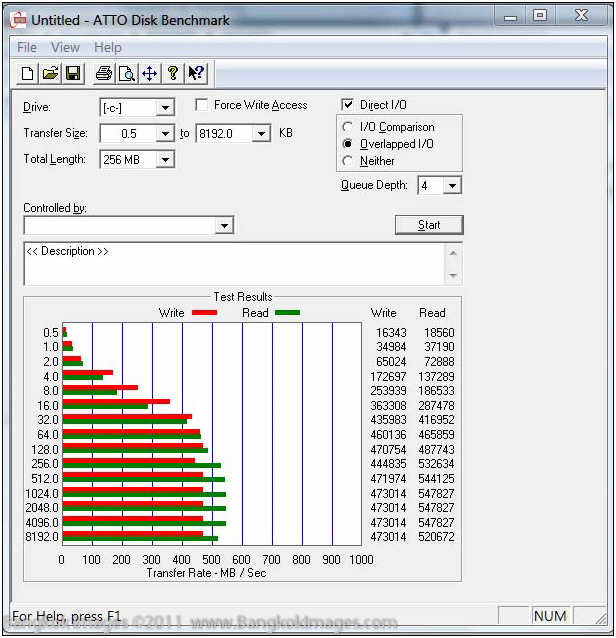
Summary
The OCZ RevoDrive is a great value in the 240gb capacity, it’s the fastest drive available next to its older brother the RevoDrive 2, and other than the obvious need of a PCI Express x4, x8, or x16 slot and the need to install drivers during the Windows Installation process I see no distracters other than its lack of TRIM support.
TRIM is a utility built into Windows that essentially rezero’s recently released space so there’s no or little degradation in performance over time. TRIM doesn’t work with ANY RAID SSD. They might find a way to make it work in the future, but for now it doesn’t work. Instead the SandForce controllers have their own algorithm which is a sort of “lazy garbage collection” and it’s known to work quite well for normal desktop usage. Hopefully in the future OCZ will come out with something a bit more substantial.

If you’ve got the spare PCI Express x4, x8, or x16 slot I see very little argument against using the OCZ RevoDrive. It’s faster, very reliable, frees up a regular drive bay, and is less expensive than regular SSD’s of like performance and capacity. If there was an argument against the RevoDrive it would be the future use of the SSD. Will your next computer be a desktop, will it have a spare PCIe slot? And don’t forget a regular SSD can be handed down to your laptop when the next greatest SSD comes along.
But if you want the fastest SSD available in a performance orientated workstation this is the SSD you want. Nothing else comes close. Until next spring maybe.. as I was writing this review I was watching the live news from CES 2011 and OCZ just announced new SATA III SSD's using a brand new SandForce SF-2000 controller with claimed speeds of both read and write approaching 500mbps, almost equal to this RevoDrive. We certainly live in great times!
I hope you’ve found this review useful.
Photography News of Interest *menu
Sometimes photographs are just humorous. Does this pitcher look a bit..well.. umm.. ‘busty’ to you?

The winners of the National Geographic Photo Contest can be read and their pictures viewed at this link. Some really awesome images.

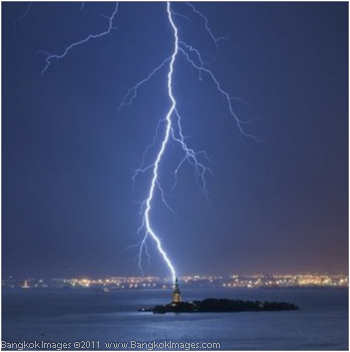

Canon releases firmware update 1.0.8 for their popular EOS 60D. This fixes some issues with overexposure and flash
control.

“Hourglass Syndrome” has been studied and it’s been determined over 80 percent of us experience Computer Rage because our PCs are too damn slow. I guarantee you that isn’t happening over here.. J

This image was front and center on the Drudge Report which is one of the most visited sites on this planet. I can’t help but think in this case a picture really is worth a thousand words. If you know he personalities you’ve gotta laugh.

Digital Photography Review previews therecently announced Olympus E-PL2 micro-4/3’s camera. This is a small camera with
the potential for really good image quality, so give it a look .

Talk about a bit of luck.. well.. kinda.. If you’ve got to be shot and murdered you might as well get lucky with the camera and photograph the killer shooting you. This is exactly
what happened in the Philippines recently. Read more about this image here.

Readers Submissions *menu
Hi Steve,
Here are a few images taken in Battambang, Cambodia. These were captured at the beginning of December 2009. Battambang is Cambodia's second largest city & leading rice producing province. It's also a nice place to observe the rural way of life. I traveled around the province for two days with a moto (motorbike with a carriage attached to it).

The border crossing between Thailand & Cambodia, the Thai side is called Aranyaprathet, the Cambodian, Poipet.

A suspension bridge over the Stung Sangker river.

The man & boy were collecting edible beetles & bugs.


Passing a family in their bullock cart, I had to slow my driver down so they would not have to eat to much dust & I could take some photos. Atop the Phnom Sampeou mountain is Wat Sampeou and a group of caves used as killing caves by the Khmer Rouge.



Inside the caves.
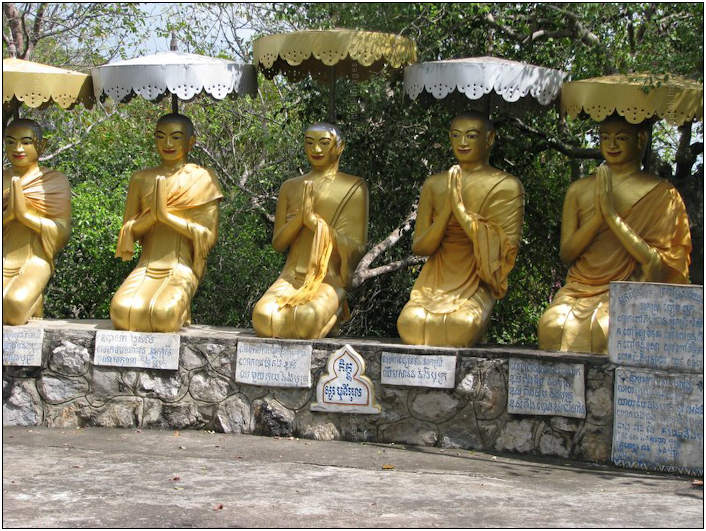
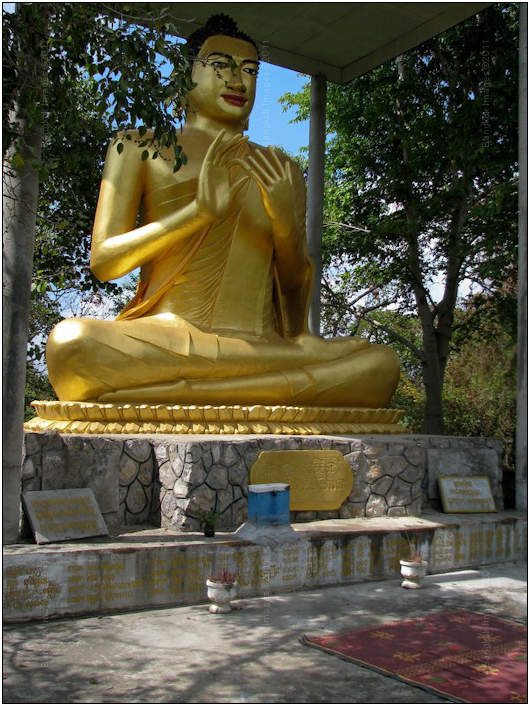
Buddhas on top of the mountain.
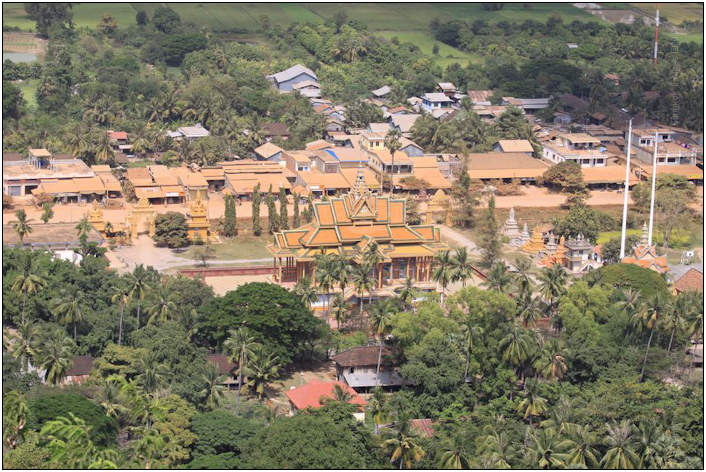
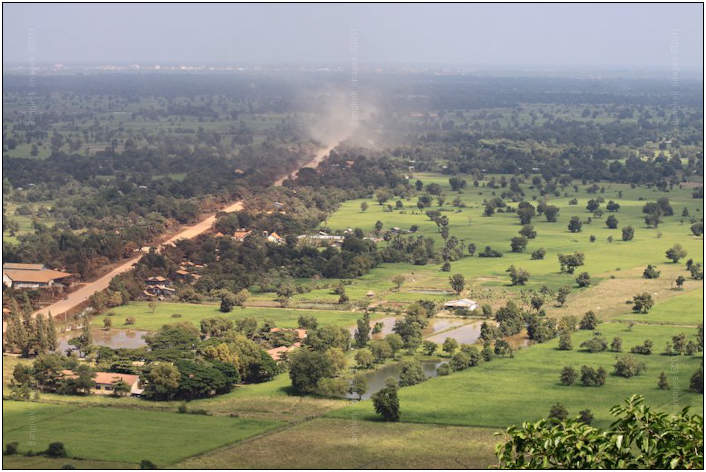
Looking down from the mountain top at the surrounding countryside, you can see how dusty it is when a vehicle drives along an unpaved road.
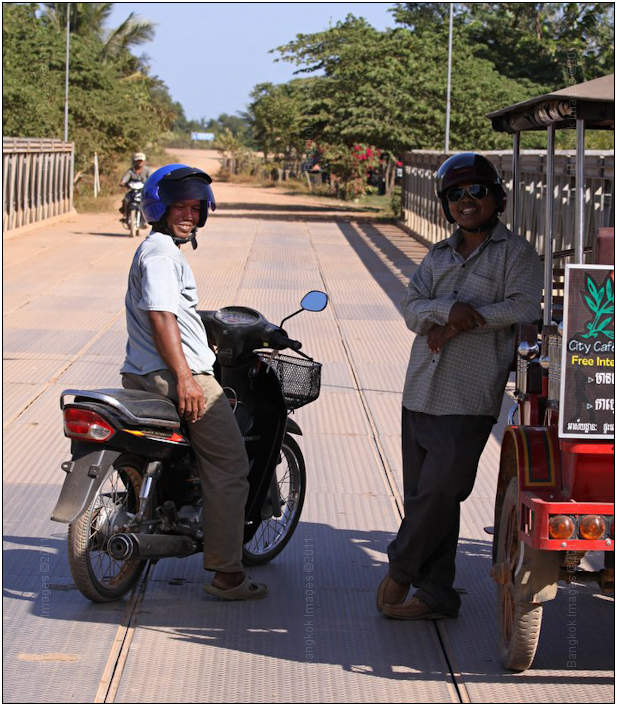
This is my moto driver with a curious passerby.
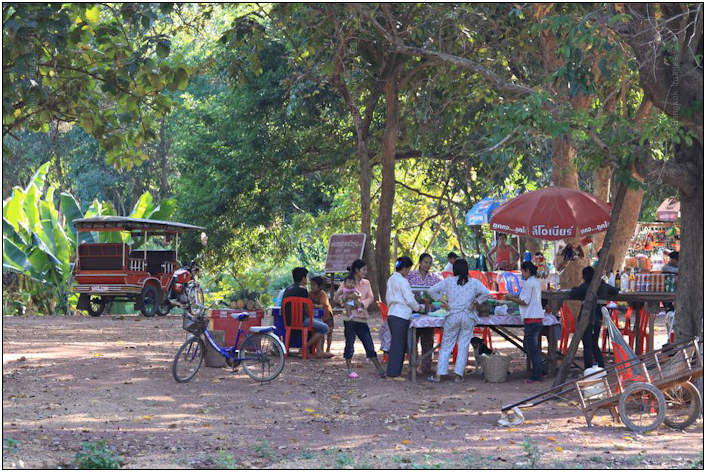
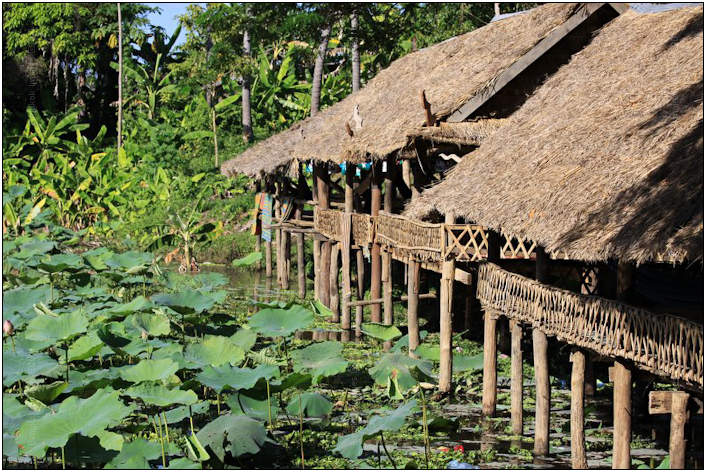
Food stalls and straw huts on a pond where you can sit & eat at one of the sites, probably Phnom Banan.
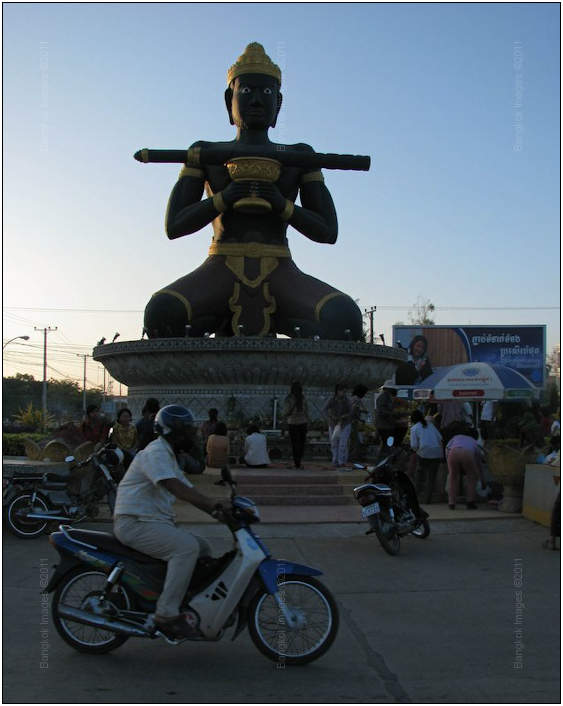
Battambang means "disappearing stick", and this is a statue of the legendary stick king. It's a little dark as dusk was approaching.
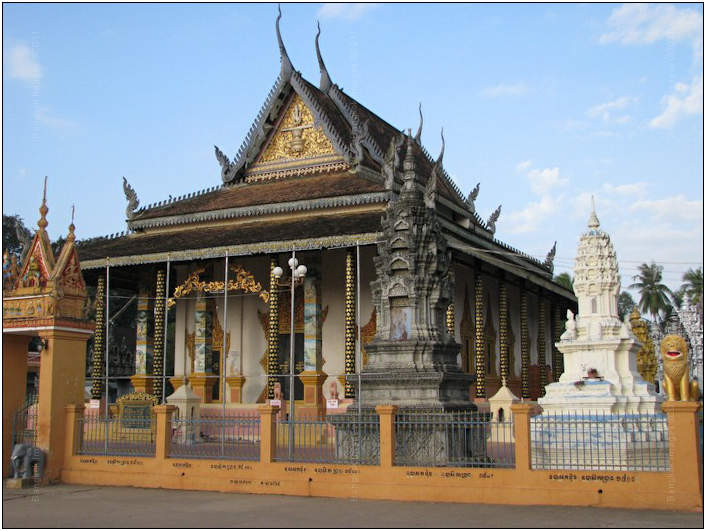
There are many wats, some are in the Thai style as Siam ruled Battambang & Siam Reap from 1790 until 1907.
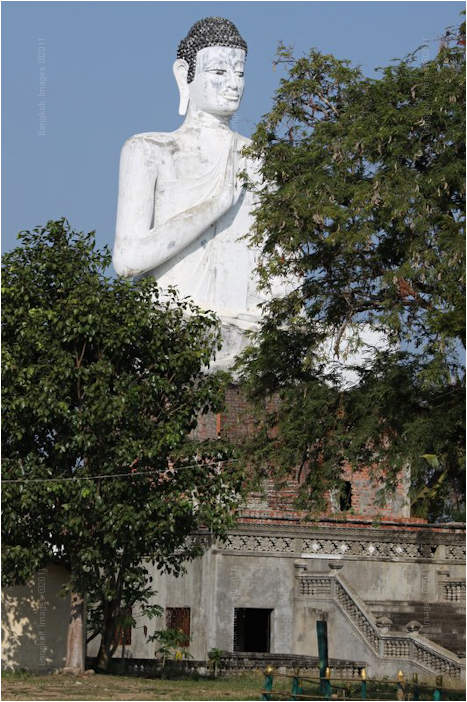
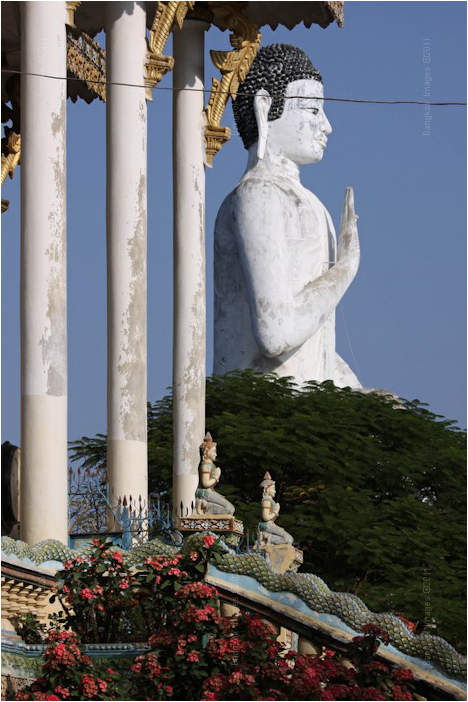
Big Buddha, Wat Phnom Ek, the statue is 28 feet tall.
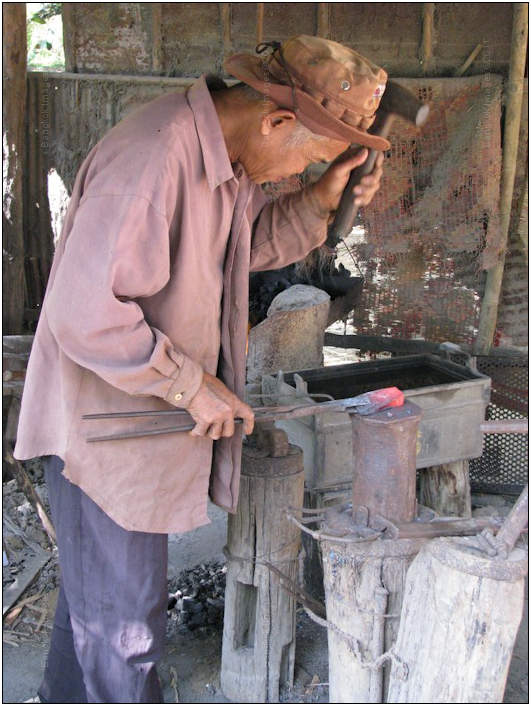
A village blacksmith at work.
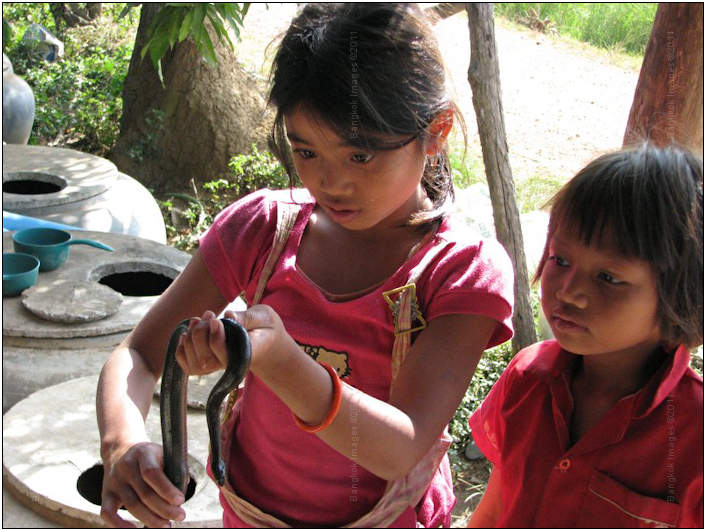
Fish drying on the Stung River.
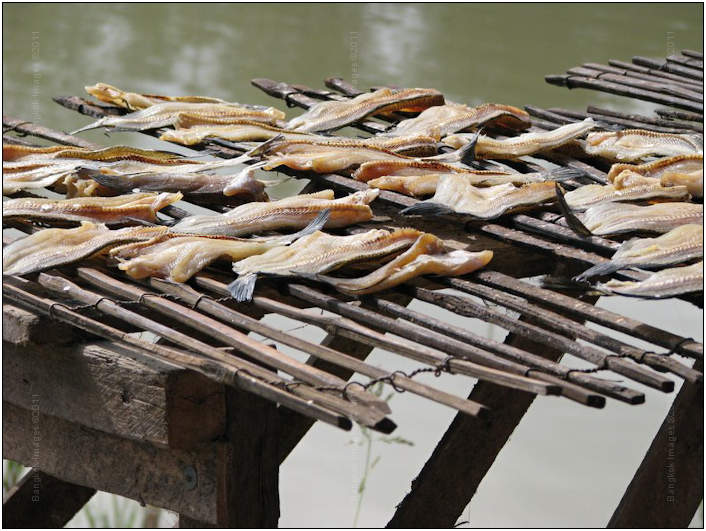
Little girls showing me that was in the jars.
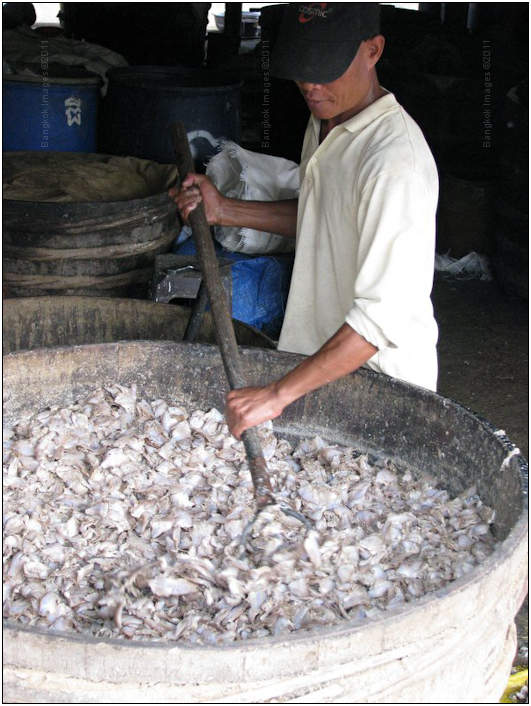
These images were taken in a fish sauce factory. My moto driver warned me that foreigners could not stand the smell, but I didn't find it that bad.
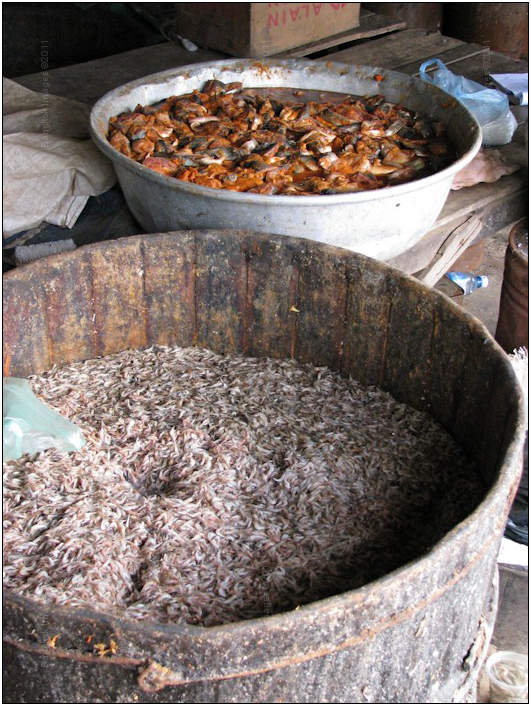
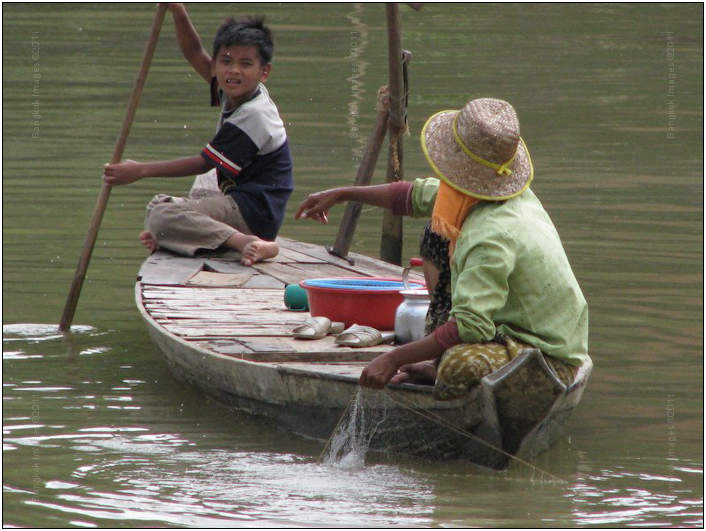
Workers in the back of a jeep under my hotel balcony.
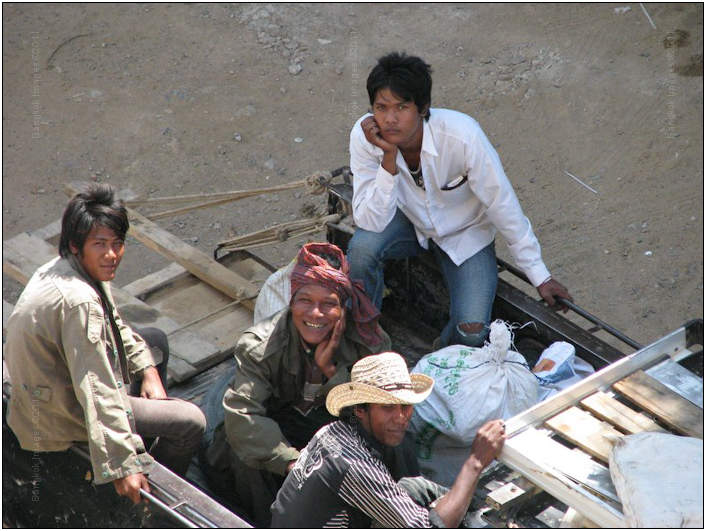
Statue of a Cambodian farmer.
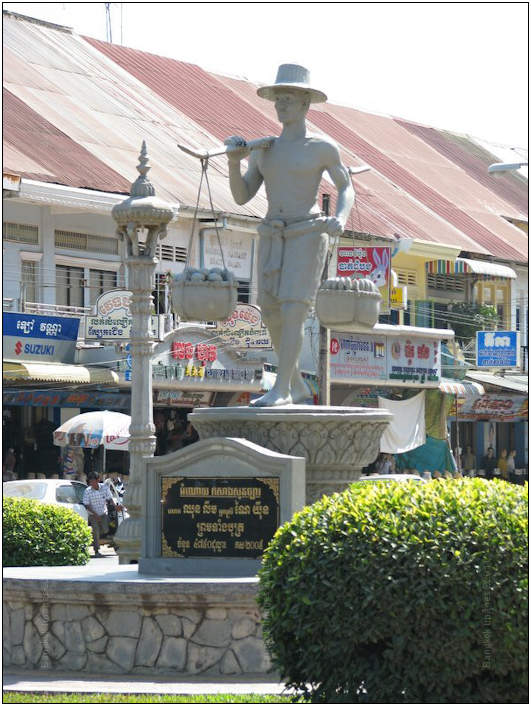
Statues are everywhere in Battambang, parks, roundabouts on nearly every street corner.
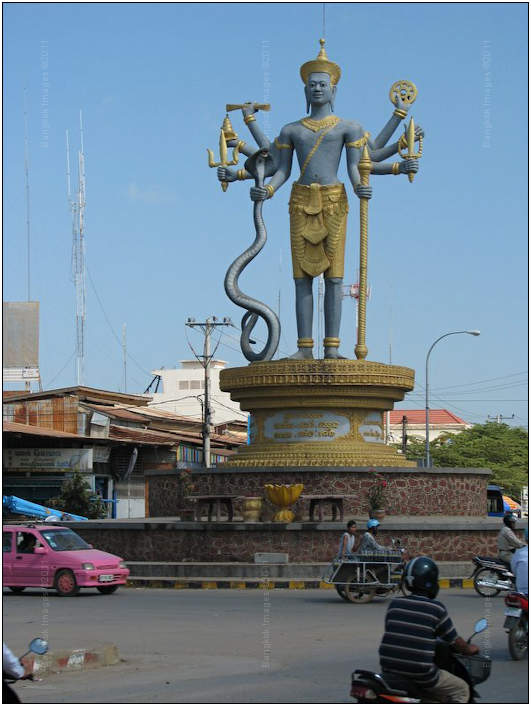
Railway bridge over the river.
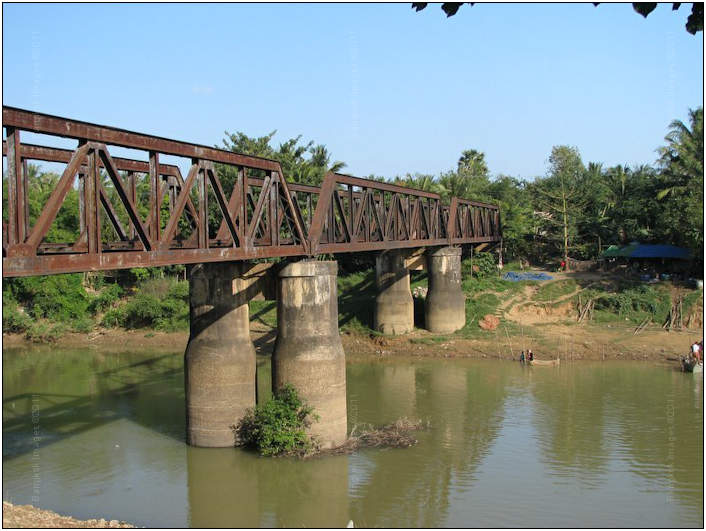
Boats & houses on the Stung River.
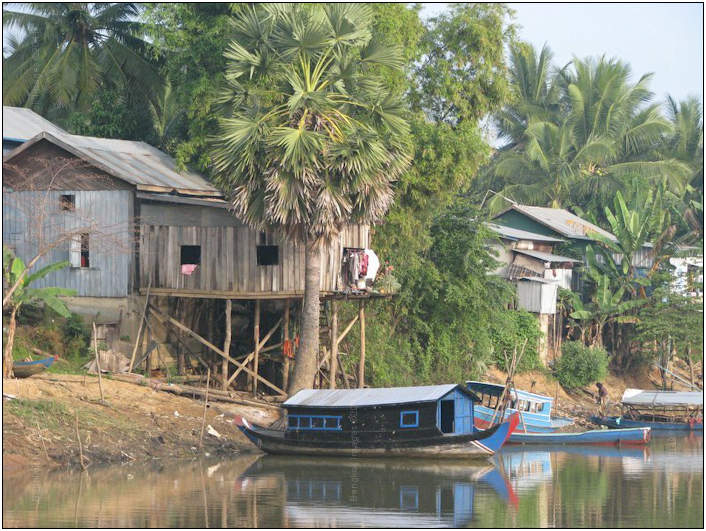
These shots were taken with a Canon EOS 50D and Powershot S5 IS, I used the Powershot a lot because of the dust on the unsealed roads. I would like to go back to Battambang in the rainy season when everything should be green and not so dusty.
Regards Khunklit.
Khunklit –
What a great look at Battambang Cambodia! Your images have a very ‘real’ authentic feel to them. The fish sauce images were interesting, but I really liked the picture of the blacksmith. The families riding the oxcarts carry a lot of impact as well.
Thank you! I’m sure many will enjoy these.
Steve
I suspect the readers submissions will be a highly anticipated section of this column and I encourage anyone with photographs and travel accounts they'd like to share to please send them to me at: info@BangkokImages.com
Readers' Questions *menu
Hi Steve
I been to IT computer in C.M .I ask there about XD picture card for my Finepix f-31. I was told that they are not for sale anymore, at least in this computer center. How come? Where can we get such cards?
Eyal
Eyal –
They make them.. look for a store that sells Olympus cameras.. they’re big with Olympus.
They’re not a big seller, so you won’t see them in many general purpose computer stores.. but any camera store selling Olympus products will have them.
Steve (I ended up finding these for Eyal here in Bangkok and mailing them to him up north)
Fred G. asked me in person where the Nikon Service Center was and their prices for cleaning and servicing. It took me a few weeks to come up with the right answers and I thought I’d share this information here.
Hello Fred –
I have the information I’ll share below and soon in the column. I was disappointed with the Nikon service center and was hoping my assistant would find me to be wrong, but it didn’t turn out that way.
Address: 156 Silom 12 Rd, Bangrak, Bangkok 10500
Phone: 02-235-2929-34, 02-263-6570-4
Email: Support@niksthailand.com Showroom@niksthailand.com
Hours: M-F 830am to 530pm
If in warranty cleaning the body and sensor is baht 500. Out of warranty 1,000 baht. 2,000 – 3,000 baht for a lens depending, with no break for being under warranty! If in warranty you can pick it up the next day, out of warranty takes a week!
I find this really unacceptable. First, their location is very difficult to get to, parking is impossible, and it’s really nothing more than a store. At first I couldn’t believe this place was a modern service center.
In contrast the Canon service center is in a modern tower building on Sathorn, with a huge, giant showroom, and a modern service center staffed at all times. Access and parking is easy, and they even feed you while you wait. The techs will even come out and talk to you if you have an unusual issue.
Prices: Canon is 450 baht cleaning for any body or lens. CPS members receive a 30% discount. I’ve used this service many times – they do it while you wait, and they’re excellent. Nikon prices are very high and making you wait a week is disappointing at best.
This is the same information I learned almost two weeks ago, but before putting this sort of information out in my column I wanted to verify in the event there was a language issue and I’d missed something. My assistant verified I’d missed nothing.
I’d still get your gear cleaned there.. no choice really.. and for the body it’s not so bad.. but the lens charges are very expensive. Almost western service center prices.
Steve
Please submit your questions to info@BangkokImages.com All questions will be answered and most will show up in the weekly column.
A Snapshot of Bangkok Images Week in Review *menu

After a long two weeks off I’m not sure where to start. There have been zero workshops or other assignments during this time. Mostly I’ve closed out the yearly administrative records and spent a fair amount of time planning new material for the column in the new year.
We’ve built an exciting new very small footprint powerhouse workstation which I hope to bring you a review of next week, I’m reviewing a super fast PCIe SSD card, and a gaming NIC for that extra edge when gaming online. We still have several imaging monitor reviews to complete as well as several new pieces of software.
I’ve posted a new gallery of images from Samut Songkram’s Boat Yards.
The User Galleries on www.bangkokimages.com are growing and there’s a lot of interesting images to check out.
The User Gallery of the week is Sunny Valentines“Titans of Rock” gallery. Really good work! Check it out.
Positive comments continue to pour in about our new look and much faster more interactive site. If you haven’t already checked it out, visit www.bangkokimages.com to see my latest galleries , share your own galleries , participate in the forums, and scour our large repository of photography related articles. The“What’s New” page continues to be very popular with almost daily updates and interesting content.
Infocus Blog, Cycling Thailand *menu

I hope my title isn’t misleading. This isn’t about bikes of any type despite the image of the wanker cyclist above. This is about how your perception of Thailand ‘cycles’ through the good and the bad. How you
perceive almost anything always changes and often evolves. Your life as it relates to Thailand is almost guaranteed a sort of renewal, an epoch you’ll recognize as the same but different starting point where you’ve stood once before.
A new era. A different but same Thailand.
Your ability to ‘see’ and accept this cycle is heavily dependent on your intelligence and mental maturity. These cycles aren’t limited to just Thailand, but to everything in life. Life is a series of evolving circles
of events often overlapping and almost always touching. Allow me to provide some examples:
Marriage. Everyone seeks the key to a successful marriage. Some say love, others say religion, like education, common interests, sexual compatibility, financial health and the list continues. All of these things are important, but a marriage can fail
regardless. I’m personally convinced love cycles. Simply put individuals fall in and out of love regularly, perhaps even for the above reasons. We would never tell our partners this, and we certainly wouldn’t want to hear it from
them. Yet, it happens. If there is a key to a successful marriage I’m convinced it would be in acknowledging the cycle of love and being committed enough to marriage to wait out the lulls in anticipation of the coming epoch. The new beginning.
And of course we can work harder to achieve this.
Photography. Like any hobby our interest in photography cycles. At first we’re excited and thrilled with each new piece of equipment, learned technique, or awesome images from a new destination. But like anything else, life often gets in the way
and we find ourselves sidetracked. Or maybe we just get bored. And then something happens to renew our interest, perhaps new more capable equipment (digital photography was the catalyst for many old-timers to return to the fold),
or relocating to a new and exciting land. And BINGO, we’re once again at a new beginning searching out the latest gear and techniques, but this time with the experience of the last era under our belt.
Thailand. I’m sure we all remember how fresh and exciting our first weeks, months, or even years were in the Kingdom. So much to see, a new culture to experience, languages to learn. At first our enthusiasm is keen, each day a new adventure. We
start thinking how great it would be to move here permanently, and many start making plans for early retirement, or even accepting any available position to get here while they’re still young. The thrill is everything.
But then something happens. Slowly the shine wears thin. The ‘wear’ is brought on by things we first didn’t see or if we did see, we overlooked or discounted. Corruption, poor attitudes towards farangs, immigration
hassles, local business ethics, poor customer service, lack of professionalism, dishonesty, lack of legal rights, inflation, racism, sexism, and so much more.
We all see the same things, but perhaps in a different order, and depending on our frames of reference we assign a different order of importance to each. But nonetheless the shine fades. Day by day.
It’s easy to recognize when a mate declares “I LOVE THAILAND, I’M GOING TO CASH OUT MY LIFE IN THE WEST AND MOVE HERE IMMEDIATELY!!!” that in many if not most cases they’re acting too hastily. If only
they had the benefit of your experience they’d slow down and consider much more. Right?
Having lived in Asia almost all of my adult life I’ve noticed something else. Those who do move here, can call it quits and pack up and leave with just as much haste! I’ve seen it many times. They move here on an impulse, often leaving behind
career and family, and everything is great. Then the shine wears thin. And again on an impulse they move back to their country.
If the person is wealthy or even well off financially this isn’t so much a problem, in fact some call it living the good life. But if you’re in the middle of your working years, you could very well find yourself back ‘home’ working as a greeter at Wal-Mart. Very few will have the opportunity to just step back into their old jobs, and most would be unwilling to start at the bottom all over again. Assuming an employer would let them at their age. Chances are they won’t.
Worse, your frame of reference, your very perspective on life and all things important to you, has been forever changed by your time in another country. You won’t have the same frame of reference as those at ‘home’.
This can severely affect your family and social lives. It can leave you feeling very discontented and somewhat of an outsider. It can leave you angry and developing bad feelings towards those unable to understand your perspective.
In short, ‘fitting in’ and learning to be happy when returning home, I’m convinced is infinitely more difficult than when arriving in Thailand. Perhaps for many, impossible.
And every time you make the big transition, either to come here or to return home, it costs in both financial and ‘opportunity cost’ terms. These costs are often huge.
Why is this topic on my mind? Because I’m cycling. I’m not happy with many things about Thailand, and how I see Thailand, both changing and not changing. I’m disappointed and in some ways hurt. Like Stick I’ve been putting
a great deal of thought into my future here in Thailand and frankly I’m not sure if I’ll be here this time next year.
Yet, ‘the cycle’ won’t be the reason I leave. I can intellectually internalize my perceptions and I’ve lived long enough to recognize them for what they are. Part of the cycle. IF I leave Thailand it would
be to give up much of what I love here, for what I love more there. It would be personal. It would be family.
Family also cycles, and an epoch nears. A new beginning. A new era. I’m just not sure if I’ll be able to take advantage of it.
Where are you in the cycle?
Until next time..




